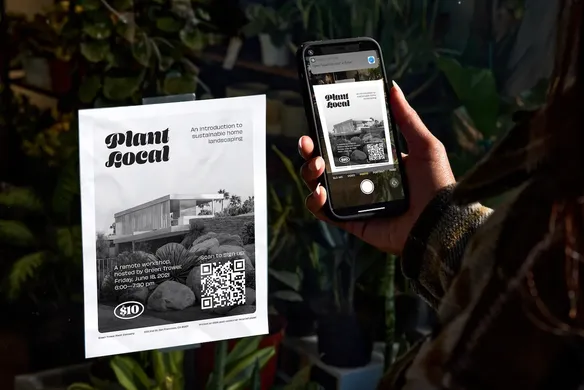Table of contents
Retailers that do omnichannel marketing well create a seamless brand ecosystem that leverages in-store, mobile, and desktop channels to further engage customers and nurture them along their buying journey.
Deep Dive
Multichannel marketing vs. omnichannel: Is there a difference?
Many people use multichannel marketing and omnichannel marketing interchangeably. But they’re actually quite different.
At its most basic level, multichannel marketing is a company’s distribution strategy — it describes the various avenues used to push messages out to customers. One way to think of multichannel marketing is as avenues moving from the inside outward to reach customers. For example, a brand markets its holiday campaign to the world via TV ads, social media posts, email newsletters, direct mail, and in-store promotions, all in parallel.
Omnichannel marketing is all about connecting the dots between the channels. Think of it as something more like a web — bringing everything together — as opposed to pushing everything outward. It keeps customers moving around within the brand ecosystem, with each channel working in harmony to nurture more sales and engagement.
An omnichannel marketing strategy may include things like cross-channel loyalty programs, in-store pickup, smartphone apps to compare prices or download coupons, interactive in-store digital lookbooks, or price checkers on tablets throughout the store.
Omnichannel retail is growing
Consumers are increasingly connected — and they expect convenience.
They channel-hop from online stores to physical stores and social media; they use smartphones and tablets, apps, and other avenues. They look up product reviews on their mobile devices while they’re in the store or on their desktops at home. They extensively compare prices amongst your competitors. They check social media channels to see if there are any discounts, or to see what others are saying about your brand. They want shipping flexibility — the option to choose whether they can get something delivered or pick it up at your store that same day.
And most important, they want the experience to be delightful, seamless, and personalised to their preferences.
Savvy businesses are taking note and starting to invest heavily in omnichannel retail, especially in digital integrations. A JDA study found that 57 percent of CEOs ranked creating new customer experiences as their top spending initiative to improve business operations.
The good news is that investing in omnichannel retail pays off big time. Through data and insights about consumer behavior across channels, companies can paint a comprehensive picture of their customers’ buying patterns. Businesses can gain a better, real-time understanding of their customers, which allows them to target promotional content and engagement campaigns toward the immediate, specific needs of each channel.
As a result, the return on investment (ROI) in sales is significant. A study by the Harvard Business Review found that omnichannel customers spend an average of four percent more every time they shop in the store and ten percent more online than single-channel customers.
What’s more, with each additional sales channel they used (mobile, apps, desktop browsing), they spent more money. Customers who used more than four sales channels spent nine percent more in the store than customers who used just one sales channel.
How to create your omnichannel marketing strategy
1. Gather research.
To move into omnichannel retail, you need to get a baseline understanding of how your customers interact with your business. Your first stop? Your data.
Analyse the data in your eCommerce platform to determine where people are engaging with your brand, and where they might need a little nurturing. You should look at item sales, of course, but don’t forget about other digital metrics. These include traffic numbers (as well as how it’s broken up between desktop and mobile), traffic sources, page views, bounce rate, and where the most people drop off from your checkout flow.
Also look at your in-store data. Your POS has robust metrics on everything from your busiest time of day to how many repeat versus one-time customers you have and even how your Facebook ads and digital loyalty program are driving in-store sales.
Qualitative research is just as important. Talk to your customers about what they like most and least about their experience with your business. What are their pain points? Would they buy more if they could pick up items in the store? How about if they could shop in the store but order online for it to be delivered? Would they be more apt to shop with you if you had a rewards program? What type? Customer surveys can help tremendously with gathering this data.
Once you have all your numbers and feedback, you’ll have a 360-degree view of your customer’s shopping behavior and preferences. You’ll know on which channels they’re engaging with your brand the most, and which they would use more if you beefed up the experience.
This is the foundation on which to build your omnichannel retail strategy. It allows you to find ways to connect the dots by inserting strategic reengagement tactics along all the touchpoints that a consumer has with your brand. This sort of data deep dive can also help you figure out which types of customers are your most valuable.
“Omnichannel gives organisations a strategic capability to get close to their customers they couldn’t have imagined 20 years ago,” says Peter Fader, the former co-director of the Wharton Customer Analytics Initiative. By using analytics, “businesses can really begin to see who the whales are — their best customers — and differentiate them from the minnows. They can see what makes the whales different and then build their business around them.”
2. Make sure you have the basics in place.
You can’t run before you walk. A successful omnichannel retail strategy requires that you have some building blocks in place first. Make sure you’ve implementing the following:
- Search engine optimisation (SEO)
You won’t even make a blip on people’s radars if they can’t find you. That’s why SEO, which consists of optimizing a website with keywords to achieve higher rankings in search engines, is critical. In fact, Deloitte reports that 65 percent of retailers say that SEO is an important part of their marketing strategy. - Search engine marketing (SEM)
Investing in SEM — that is, purchasing online marketing like keywords — is also important. Forty-six percent of retailers rate SEM as a key piece of their marketing strategy. - Mobile-optimised website
According to research by CWCS Managed Hosting, only 18 percent of people would recommend a business if they had a bad mobile shopping experience. Make sure that any eCommerce platform you choose works just as well on mobile devices as it does on desktops. - Targeted email campaigns
Targeted email campaigns, which 46 percent of of e-retailers rank as critically important, are a low-lift, cost-effective way to deliver personalised, actionable content to customers. - Social media
Forty-four percent of retailers say social media is vital. With its easy-to-use, advanced targeting capabilities, Facebook is especially important as a way to reach customers. It’s also a great way to create buzz.
Square makes it easy for customers to discover you on social media. [Square’s Facebook ad integration][11] helps you target customers on Facebook, get new customers in the door, and increase sales effectively. Your Facebook Ads results and Square sales data are also integrated, so you can connect your Facebook marketing budget to actual sales and understand exactly what your customers respond to. You can also sell directly from Instagram by creating shoppable posts.
3. Reorganise your business operations.
Omnichannel retail is all about creating an ecosystem, but many businesses are organised around a system of siloed channels. There may be one department responsible for email newsletters, another for customer service, another for events, and yet another for content marketing. If these departments aren’t working together closely, it’s going to be impossible for an omnichannel retail strategy to gel.
Make sure you include increased interaction with other channels as a key success metric for each of your departments. You might even consider reorganising your marketing department’s reporting structure so that everyone is marching toward the same goal (rather than siloed ones).
You want your employees to constantly be looking for ways to move customers seamlessly through all the company’s engagement channels. Toward that end, PwC reports that Neiman Marcus merged its online and offline divisions so that the same team oversees merchandising, planning, and marketing for its brick-and-mortar and online stores. And some companies, like Macy’s, have even hired chief omnichannel officers.
It’s also important to think about your business’s technology environment. To support omnichannel retail, 81 percent of retail executives plan to implement a unified commerce platform over the next decade to consolidate key data, business rules, and functionality that historically have lived in different systems. Bring in-store and online retail together by choosing a POS system that syncs inventory across channels.
Creating a way for everyone in the company to easily get a holistic view of your business is paramount for success in omnichannel retail. By merging data and insights across channels, companies gain a better understanding of customer behavior and preferences, allowing them to produce promotional content, product recommendations, and engagement tactics targeted at their immediate needs.
4. Map out the customer journey.
Using data and insights, map out the web of how customers typically traverse all your channels.
Do people browse your products online before visiting your store? Do they visit your store and buy online? Are people more likely to buy a certain type of product online versus in stores? Do customers who read your educational content tend to buy something as a result? How likely is it that someone who signs up for your loyalty program becomes a repeat customer? How do your Facebook ads drive your in-store sales?
Drawing out all of the ways people interact with your brand and then buy your products gives you a picture of what your omnichannel ecosystem looks like right now. If you can anticipate how all of the channels are traversed, you can begin to understand customer preferences. And if you see a key section of the web faltering (or even missing), you can find a way to fill in that line.
5. Start with a few customer paths.
It’s best to start small, especially if you’re new to omnichannel retail. Pick out a few customer paths and figure out what might work to nurture them along from their starting point to a sale. McKinsey recommends creating different “customer personas.”
Say, for example, that you’ve found that there’s a cohort of people who read tons of online reviews of your products before making a purchase. You might consider adding touchscreens in your brick-and-mortar store so customers can look up product reviews right there. Another way to engage those information-hungry customers is to serve them in-depth educational content about your products as they’re browsing your website, or through retargeted Facebook ads based on their shopping behavior.
Fulfilment options are also a good place to start, especially if you notice customers are abandoning their online carts due to high shipping costs. In fact, PwC found that 71 percent of CEOs say that omnichannel fulfillment is a top priority for their business. You might consider turning your store into a mini fulfillment center by offering free in-store pickup for orders online or through your app. It can save your customers shipping fees and increase foot traffic at your brick-and-mortar store. In-store pickup has a great ROI, as someone picking up their online order may buy something additional once they see it at your storefront.
On the other side of the coin, you could save on inventory storage space and just have a physical “showroom” for your products, where customers can buy what they want on tablets in the store and get it shipped.
6. Continuously look at data and adjust your strategy.
It’s not enough to put some omnichannel marketing strategies in place and then leave them on autopilot. You have to constantly look at your data analytics to measure the results and tweak things accordingly. As the market evolves, you may even notice a whole new consumer trend that requires a different strategy across new channels.
Examples of omnichannel user experience
There are an increasing number of examples of companies that have doubled down on their omnichannel retail experience. Here are a few to draw inspiration from:
Bonobos
The men’s clothing company has led the way in an emerging omnichannel trend for online retailers: showroom-only storefronts. Bonobos Guideshops don’t actually sell anything in person, but offer the opportunity to try on items and then order them online. Customers can make an appointment online for complimentary style assistance at the store. Some Guideshops even offer them a beer when they show up.
Other companies have followed suit. Samsung opened its first showroom-only store in NYC last year, and Amazon has opened a number of brick-and-mortar locations to sell books.
Rebecca Minkoff
Rebecca Minkoff, a fashion retailer known primarily for its high-end handbags, has taken in-store technology to the next level. The result is a highly personalized, delightful shopping experience.
When consumers walk into a Rebecca Minkoff store, they’re greeted by a digital wall that lets them order a free drink, choose a few items to try on, and then request help from an employee. Salespeople, armed with iPads, retrieve the requested items and then text shoppers when their dressing room is ready. Dressing rooms are equipped with “smart mirrors” that allow customers to ask for other sizes or items. And then consumers can self–check out via tablets throughout the store so they don’t have to stand in line to pay.
Sephora
Sephora is an example of a company that has developed specific apps and leveraged new digital communication channels to personalize the shopping experience and nurture customers toward making a purchase. The makeup retailer uses online chatbots in Facebook Messenger to help shoppers find a Sephora lipstick that matches the shade in a photo they’ve uploaded. Then customers can use the Sephora Virtual Artist app to upload a selfie and “try it on.” Four million people have used the chatbot and Virtual Artist app to date.
The New York Jets
From the minute fans enter the parking lot until the last play, The New York Jets maximise enjoyment of the game while making sure that every opportunity for revenue is explored.
The team leverages robust sets of data to let employees know in real time where to send fans when parking lots are full, or to steer people away from long lines at certain restrooms during the game. POS analytics help keep inventory stocked at stands so there are always sufficient items to meet demand.
And the Jets mobile app feeds game-goers real-time commentary and lets them chat live with each other as the team provides them with stats, photos, and videos. The result is a complete 360-degree game experience.
To attract today’s connected customers, businesses need to create a web between all their customer engagement channels. The result is not only more sales but also a superior customer experience.
![]()














